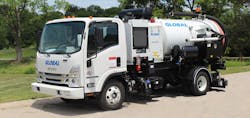De-Ice, a company using electromagnetic technology to deice aircraft sustainably, today announced that its first customer, Air Canada, will begin the first ever installation of De-Ice systems on an Airbus A320-series aircraft this winter, with other aircraft planned to follow. Today's chemical-spray ice removal process can add 30 to 45 minutes to the journey. This new technology will meaningfully reduce the departure delays and the carbon footprint associated with chemical de-icing.
De-Ice spun out of Massachusetts Institute of Technology (MIT) in 2015 when Alexander Bratianu-Badea experienced the frustration and inconvenience of flight delays due to chemical ice removal. He and co-founder Ruben Toubiana set out to develop a fast and sustainable way to deice aircraft.
Since then, the company's team of scientists and engineers has developed a novel technology that uses high-frequency electric current to deice aircraft without using chemical-based de-icing fluids. The technology also meaningfully reduces carbon dioxide (CO2) emissions. De-Ice has collaborated with regulatory and safety experts throughout the development process to bring the product to market.
"De-Ice is proud to introduce our product to the world with Air Canada," said Bratianu-Badea. "Flight delays and the excess carbon emissions caused by chemical-based de-icing will be a thing of the past."
How De-Ice Works
The De-Ice system consists of tape-like strips attached to the exterior of the airplane. The strips connect to proprietary electronics inside the aircraft. When activated by the pilot, the De-Ice system generates high-frequency current, causing electrons on the surface of the plane to jiggle, generating heat. This melts snow and ice during the boarding process, leaving the aircraft ice-free and ready for takeoff by the time the plane is ready to pull back from the gate.
"Not only will De-Ice technology be positive for our customers by reducing delays related to the conventional method of aircraft ice removal, but the environmental benefits of chemical-free de-icing and associated lower fuel consumption are in line with Air Canada's commitment to a net zero emissions goal from all global operations by 2050," said Murray Strom, Senior Vice President, Flight Operations and Maintenance at Air Canada. "We have long been an innovative company, having pioneered many winter flying safety measures, and we are proud to be the first airline in the world that will install this technology, which will be the first major advancement in de-icing technology in decades."
Using a semiconductor called gallium nitride (GaN), the De-Ice system generates high-frequency current using devices that weigh an order of magnitude less than traditional equipment. Before GaN, transistors capable of generating such high-frequency current were made of silicon, which is too inefficient to be used on aircraft for this application. Additionally, the company has developed several other inventions in power electronics and distribution to make the technology work.
Replacing Expensive, Delay-Inducing, and Chemical Sprays
The patented De-Ice system is the only product of its kind and the only viable alternative to chemical-spray ice removal. It is designed to be integrated with existing airline operations, including the installation of the device, which can be incorporated into routine maintenance visits.
Today, commercial and military aircraft use sprays made with propylene or ethylene glycol to remove ice and prevent it from accumulating. This involves manufacturing, transporting, and heating chemicals. It also results in longer taxi times to and from the central deice facilities and increased engine idling times during the de-icing process, all of which collectively generate significant CO2 emissions.
In addition to causing flight delays, this method of ice removal costs airlines worldwide billions of dollars a year to buy, transport, store, and apply the fluid.





